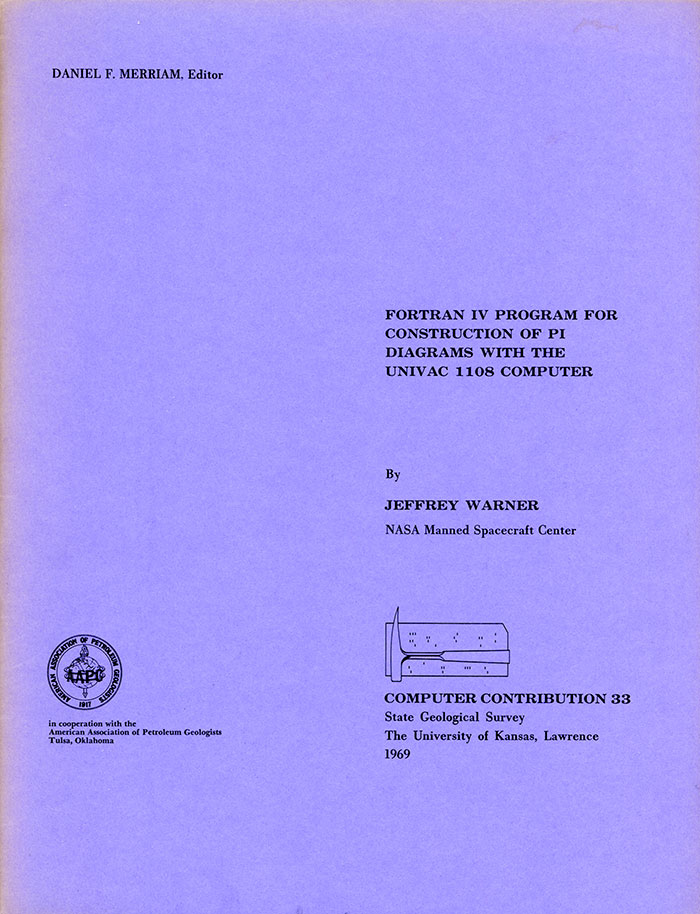
Kansas Geological Survey, Computer Contributions 33, originally published in 1969
NASA Manned Spacecraft Center

Originally published in 1969 as Kansas Geological Survey Computer Contributions 33.
Graphic analysis of fabric data by constructing orientation diagrams is a standard method in structural geology. Turner and Weiss (1963) and Whitten (1966) among others, present methods of constructing the diagrams. This paper describes a computer program, written in FORTRAN IV for the Univac 1108, for constructing the orientation diagrams. The program also has been run on IBM 7040, 7094, 360/40, 360/65, and 360/67 computers.
The program is listed in Appendix II and details of the input deck are given in Appendix I. Samples of input and output are presented in Appendix III.
I wish to thank Drs. C. Klein, D. R. Waldbaum, and M. P. Billings for helpful discussions during writing of the program. Computer funds were provided by Dr. C. Klein through NSF grant 2723 to Harvard University, the Manned Spacecraft Center of NASA, the Maine Geological Survey, Dr. P. Fenner and Dr. P. Butler of the University of Pennsylvania, and the Geology Department of Franklin and Marshall College.
The program is written to construct different types of diagrams, among which are:
Input is in the form of field or laboratory measurements as illustrated in Table 1. Input is limited to 500 data points in the present version of the program which uses less than 15K words of core. This limit can be increased to 3000 data points for a 32K machine. In addition, the program has the capability of (1) performing rotations of any data set and constructing a new diagram and (2) combining any number of rotated data sets and constructing a summary diagram.
The amount of rotation either may be read directly as input in the form of a horizontal and vertical angle of rotation or the computer will calculate the rotation angles. In the later instance input is the dip and strike of (1) the plane of input data, and (2) the plane of desired diagram.
Output is of two possible forms; the percent population per 0.01 of the hemisphere may be printed for (1) each input point (point, or short form), and (2) every other print position on the net (about 2500 points; full or long form). All data type and output form options are determined by an input control and title card.
Table 1—Types of input.
| Measurement Type |
Measurement | Input Form |
|---|---|---|
| Planes in field | N. 30° E. - 80° N.W. | N* 30 E 80 W |
| Lineations in field | 35° - S. 8° W. | S 28 W 35 |
| U-Stage data or random poles | 28° - 31° R. | 31 28 R |
| Azimuth and vertical angle | 350° - 20° | 350 20 |
| * The "N" in the strike of a plane is optional input. | ||
The chief advantage of using computer-calculated fabric diagrams result from a saving of time. This program will calculate 10 diagrams of 100 poles each, or one diagram of 500 poles in less than one minute. Thus many hours (or even days) of tedious plotting and "counting-out" are eliminated. The hand contouring (including deciding on the contour interval to be used) of a calculated diagram takes less than five minutes.
Another major advantage of calculated diagrams is that their ease of construction encourages one to make multiple analyses of his data. Once the data are punched, they may be used many times in various analyses. For example, several sets of subregions or "domains" may be set up and tested.
Read the PDF version (3.9 MB)
Kansas Geological Survey
Placed on web Aug. 29, 2019; originally published 1969.
Comments to webadmin@kgs.ku.edu
The URL for this page is http://www.kgs.ku.edu/Publications/Bulletins/CC/33/index.html